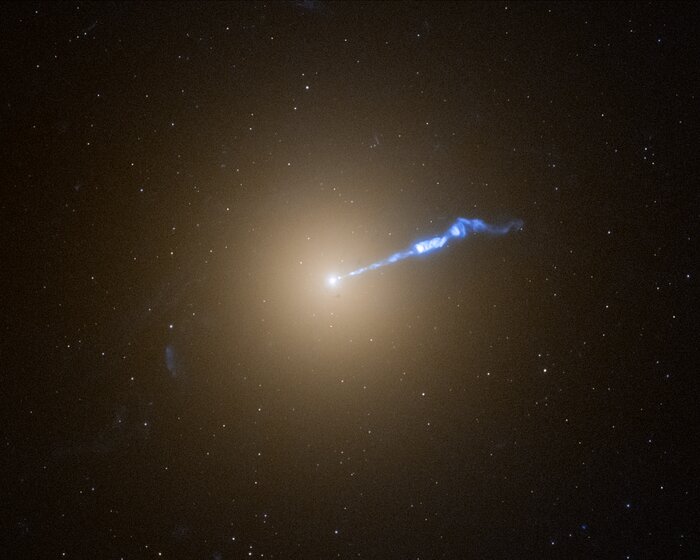M87
A Hubble Space Telescope image of the giant galaxy M87 shows a 3,000-light-year-long jet of plasma blasting from the galaxy's 6.5-billion-solar-mass central black hole. The blowtorch-like jet seems to cause stars to erupt along its trajectory. These novae are not caught inside the jet, but are apparently in a dangerous neighbourhood nearby. During a recent 9-month survey, astronomers using Hubble found twice as many of these novae going off near the jet as elsewhere in the galaxy. The galaxy is the home of several trillion stars and thousands of star-like globular star clusters.
[Image description: A Hubble photo of galaxy M87, which resembles a translucent, fuzzy white cotton ball. The brightness decreases gradually out in all directions from a bright white point of light at the centre. A wavy blue-white jet of material extends from the point-like core outward to the upper right, about halfway across the galaxy. Stars speckle the background.]
Credit:NASA, ESA, A. Lessing (Stanford University), E. Baltz (Stanford University), M. Shara (AMNH), J. DePasquale (STScI)
About the Image
| Id: | heic2411b |
|---|---|
| Type: | Observation |
| Release date: | 26 September 2024, 16:00 |
| Related releases: | heic2411 |
| Size: | 2355 x 1885 px |
About the Object
| Name: | M87 |
|---|---|
| Distance: | 53 million light years |
| Constellation: | Virgo |
| Category: | Galaxies |
Wallpapers
Coordinates
| Position (RA): | 12 30 49.26 |
|---|---|
| Position (Dec): | 12° 23' 28.06" |
| Field of view: | 1.55 x 1.24 arcminutes |
| Orientation: | North is 0.1° left of vertical |
Colours & filters
| Band | Wavelength | Telescope |
|---|---|---|
| Optical UV | 275 nm |
Hubble Space Telescope
WFC3 |
| Optical V | 606 nm |
Hubble Space Telescope
WFC3 |


